
Based on the booming of China's soybean industry, the domestic soybean food industry can produce tens of millions of tonar peas, and the residue produced by the biological enzyme method can reach 70%. Soy dietary fibers are mainly composed of cellulose, hemicellulose (40 to 60 g / 100 g), and lignin. The monomers in the bean residue polysaccharide are mainly glucose, glycondic acid, galactose, arabinose, xylose, fucose, rats, and mannose. However, it is currently used for animal feed or as waste directly to burn, causing certain economic losses. In addition, the dietary fiber products produced by the bean slag deep processing have a high water, the mouth sensation, the deterioration of deterioration, soluble dietary fiber is low, limiting the progress of the biomass process by-product processing industry, although the research of bean slag is constantly in-depth, But mostly stayed in roughing and relatively few more well-processed research. Further processing of micronization techniques can effectively improve the functional characteristics of the soybean dietary fiber, which improves the utilization of soybean resources and protects the environment. Different modification methods, such as chemistry, enzymics, and physical methods have been used to improve the physical chemistry of soybean dietary fibers. The physical approach has advantages over other methods (explained: the advantageous situation of the opposite side), such as simple technology, low cost and sustainability. Physical methods such as high pressure homogenesis, microfluidization, and ultrafine polishing are mainly changed by reducing soybean slag, oatmeal, peach and wheat particle size to change the physical chemistry and functional characteristics of dietary fibers. Ultrafine pulverization refers to the method of using mechanical or fluid power to overcome the internal cohesion force of the solid, which is broken, thereby pulverizing 3 mm of material particles to 10 μm operating techniques, is a material processing high technology.
The ultrafine powder is ultra-fine and pulverized final product, which has a special physicochemical property that is not from the general particles, such as good solubility, dispersibility, adsorption, chemical reaction activity, and the like. The ultra-fine powder has been widely used in many fields such as food, chemical, medical, cosmetics pesticides, dyes, coatings, electronics and aerospace. Based on biological enzyme-based oil process research, ultrafine pulverization-composite enzyme method is used to modify the dietary fiber modification treatment of biological fiber, using infrared spectroscopy, X-diffraction analysis (analy) different treatment conditions, structure change of soybean dietary fibers And through the aqueous, oil-resistant, expansion and granular analysis of the bean residue, and the functionality of its functionality, by low temperature ultrafine powderThe simplicity of the deviation improves the quality of the bean residue, promoting the secondary use of biomease method, and fills the research vacancies in this field, providing technical support for the development and application of bean slag. I. Materials and Methods
1. Material, Instrument and Equipment Soybeancase Level Oil Bean Residue (Laboratory Homemade); α-amylase (DA4251, Enzymatic ≥10 000 U / g); cellulase (enzyme activity ≥10 000 U / g);
Lowry test solubility kit. S22-2 constant temperature magnetic stirrer; Al 204 analysis balance; PHS-3 C wire magnetic pH meter; WZJ-100 ultra-microfiner (company); TDL-408 table centrifuge; HH-4 digital stirring water bath Pot; blast drying box; S-3400 N electronic scanning microscope; laser particle size meter. The ultrafine pulverizer utilizes air separation, heavy polishing, and shear, the ultrafine manner is used to achieve a dry material ultrafine pulverized apparatus. It consists of a cylindrical crushed chamber, a polishing wheel, a polishing rail, a fan, a material collection system, and the like. The material enters the cylindrical pulverizing chamber by the feed opening, and is crushed by the polishing wheel that is circumferential movement along the grinding rail, and dissensibly.
2. Low enzyme-based oily paans, dietary fiber preparation will be killed in commercially available soybeans, over 60 mesh sieve, take 200 g of sieve powder, from 1 to 6 (g / ml) to add distilled water, to be mixed After the uniform (jūn yún) was placed in a 55 ° C water bath, the enzymatic solution was: the enzymatic hydrolysis temperature of 55 ° C, the enzymatic hydrolysis time 2 h, the pH was maintained at 9.0, the alkaline protease Protex6L (8 900 u / ml) After the amount of addition is 0.5%, the alkaliolysis is stirred, and the enzymatic solution is completed, and the water solution pH 7 is removed and used with 1 mol / l HCl solution, and then the enzyme is 5 min in boiling water at 100 ° C, and the solution after ionure after 4 500 r / min, 20 minutes under condition centrifugal operation, the soy slag is placed in a plate of 55 ° C, and the grinding is removed by the rendering of the desired enzyme. Due to the fat oxidation in the softened oxidation, the odor is generated and the extraction rate is affected, and therefore, the fat is removed in accordance with Yang Mengxi before extracting the dietary fiber.
The ultrafine pulverizer was used to ultrafine pulverization method (moisture ≤ 4%) at -4 ° C, and the pulverization time was 30 S, and the discharge particle size was 100, 200 and 300, respectively, dried to mass constant.
3. Mean determination of the particle size of the bean residue IDF. The particle size of the sample particles was analyzed by a laser particle size analyzer. The injector is Hydro 2000 Mu (a), the particle refractive index of 1.460, the particle absorption rate of 0.1, with deionized water as a dispersant, the dispersant refractive index of 1.33, and the particle size range of 0.02 to 2 000 μm.
4. Expansion capability (SC) weigh the sample (250 mg) into a 10 mL cylinder (0.1 mL scale) and 5 mL distillation (STILL) water, and 0.02% azide sodium is added. Gently stir it to eliminate the trapped bubbles and place it overnight at room temperature to settle the sample. Measure the volume (ml) occupied by the sample. Inflate ratio (ml / g) = (expansive sample volume-dry sample volume) / sample dry mass
5. Water supply capacity (WRC) adds 250 mg of samples and 15 mL distilled water to 50 ml of centrifuge tube. After stirring, place 1 h at room temperature. After 3 000 × g centrifugation 20 min, the supernatant, the residue mass was discarded, and the moisture mass (G) of each gram sample was calculated. Painting capacity (g / g) = (residue quality - Sample dry mass) / sample dry mass
6. Scanning electron microscopy, dry, crushing and sieving softening dietary fiber samples, a method for gilding by ion sputtering, by scanning electron microscope The preparative sample was superplified by 1 000 times amplification, analyzed to obtain a corresponding scanning electron microscope picture. Ultrafine pulverizer is a fine powder and ultrafine powder pulverization equipment, which is mainly suitable for medium, low hardness, humidity of less than 6%, and a non-flammable and explosive non-metallic material of the Moh's hardness is below 9. For any fibrous, high toughness, high hardness, or materials having a certain water rate can be adapted. The material of the cell wall and other spore plants, which are higher than 95%. At the same time, it is suitable for dry and wet crushing.
Wet, water, alcohol or other liquid can be added thereto. 7. Fourier transform infrared spectroscopy (FTIR) After freezing the soy saffling dietary fiber under different treated, the FTIR spectrometer measures the change in the molecular structure, the wave number range 400 ~ 4 000 cm-1, and each sample is scanned 32 times. 8. X-ray diffraction (XRD) is analyzed by an Analyze sample crystal structure by an X-ray diffractometer. Set generator voltage40 kV, ERRON FLOW 150 mA, anti-hair loss slit 2/3, using Cuka radiation (1 μ = 0.15 nm), data is recorded at 1 π / min of 5 ° ~ 60 ° in the diffraction angle of 5 ° ~ 60 °. The crystallinity on the X-ray diffraction diagram is calculated by calculating the area of the curve. DC = AC / (AC + AA) × 100%: AC is a crystalline area; AA is an amorphous area. 9. Data statistics and analysis of all tests for at least 3 repetitions, using Software for ANOVA differential significance analysis, P <0.05 is a significant difference. Second, the results and discussion
1. The basic composition of the enzyme legal oil bean slag is the basic ingredients of the bean slag and the percentage of the percentage of the contents of the softening conditions, wherein the samples A, B, C, and D indicate untreated, low temperature ultrafine pulverization treatment 100. , 200 and 300 destination softening samples.
2. The granular distribution analysis is diagram as the particle size distribution of soybean dietary fibers under different pulverization conditions. When the ultrafine pulverizer works, the material that needs to be pulverized from the feed homper side of the side of the machine cover, relying on the grinding roller apparatus suspended on the main chamber frame, rotating around the vertical axis, while itself rotates, due to rotation The action of centrifugation, the grinding roller is swinging, tightly pressed into the mill, and the shovel shovel is sent between the mill and the abrasive ring, and the purpose of pulverizing the material is achieved due to rolling rolling of the grinding roller. In contrast, the low temperature ultrafine pulverization effectively reduces the particle size distribution of the soybean dietary fiber, and the particle size distribution of the soybean dietary fiber is widely distributed, indicating that the dietary fiber solution system under low temperature pulverization is more stable. The reason may be that the high-shear effect of ultrafine pulverization makes the particle size of the soybean dietary fiber. Further, under low temperature ultrasound treatment conditions, as the degree of pulverization is increasing, the particle size distribution is reduced, but the particle size of the dietary fiber is increased when the degree of pulverization is 300. This may be, Van Dadhui and static electricity (a charged charge) in the pulverization process, increased, promoting dietary fiber particles aggregation.
3. Physical and chemical nature analysis shows the effect of different pulverization conditions on hydropower and expansion of dietary fibers. Soy dietary fibers are inverse, and expansive increases with the degree of pulverization, indicating that ultrafine pulverization treatment of bean residers can effectively improve the holding of water-saffled dietary fibers, and expand. ThisIt may be due to the mechanical action of the ultrafine pulverization treatment so that the softening structure is small and more loose. The dimensions of the bean residue are also increased, so that they have a water capacity. At the same time, as the degree of deterioration of the granules of the bean slag causes more hydrophilic groups and parts to expose, the particle size gradually decreases, so that the bean slag is more sufficient to extend radially, thereby expand (inflate) Increase. After treatment, a water-soluble dietary fiber having a greater specific surface area is stored by a hydrogen bond or dipole formation, which improves water solubility, water supply capacity, and swelling.
4. Infrared spectroscopy (Analyze) Different crushed degree of FT-IR spectrum of the dietary fiber of the bean residue is shown in the figure. 3 000 ~ 3 650 CM-1 and 2 922 CM-1 can be observed in a certain limit of hydrogen or hydrogen (extension and indentation metaphor) in the polyhydroxymethylene group in the range. WORKAROUND OF THE INVENTION COOH and CO Substallogenic Vibration Peaks in Stripetonic Acid and Polyphen (1 738 CM-1 and 1 592 Cm-1) are shown in the presence of cellulose and hemicellulose. With [20]; 1 370 cm-1 represents CH telescopic vibration; 1 147 cm-1 and 1 052 cm-1 significant wide absorption strip is a functional group C-C-C and aromatic group C The expansion caused by -O, indicating that the soybean dietary fiber is decomposed into oligosaccharides after ultrafine pulverization. By comparing, the number of peaks and Strength have changed with the degree of crushing, which may be redistributed and formed by the effect of the molecular hydrogen bonds of cellulose and hemicellulose by shear effect. Changes caused by shaped and soluble polysaccharides. Further, after the ultrafine pulverization treatment, the bean dietary fiber spectrum is transmitted, indicating that moisture adsorption in the fiber matrix.
5. X-diffraction analysis Different ultrafine pulverization conditions to biomease (enzyme) method of oil softening dietary fiber crystal structure change, as shown, soybean dietary fibers show a strong 2θ diffraction angle peak at 22 ° 22 °, At the same time, there is also a weaker 2θ diffraction angle peak at 34 °, wherein the main diffraction peak 2θ is about 22 °, indicating that the crystalline region of the soybean dietary fiber is present and the crystal structure is a cellulose type I, and is a crystalline region and a non-crystalline region. The state coexists in the two phases. As the degree of crushing is increasing,The position of the X-diffraction peak is constant, but the strength of the diffraction peak is reduced and the diffraction peak width increases with the degree of pulverization. It is illustrated that the low temperature ultrafine pulverization makes the partial crystallization zone, and as the degree of crushing is deepened, the degree of damage of the crystal structure is increased, and this change in the crystal structure can also be confirmed by changes in crystallization intensity. In addition, the unprocessed soybean dietary fiber crystallinity index was 35.2% fell to 26.1% in the pulverized 200, which was significantly reduced to 21.5% in crushing 300. Note that the crystallinity index (%) of the dietary fiber (%) decreases significantly with the degree of comminution (P <0.05). The results show that the crystal structure of the crystalline region of the dietary fiber is transformed under high-speed shear, and the larger crystal structure is converted into small crystals, and the ordered structure of the cellulose crystalline region in the soybean residue is changed by low temperature ultrafine pulverization. Crystal structure changes. The high humidity medium polishing energy reduces the crystallinity of polysaccharide, which demonstrates that the crystal structure of the fiber polysaccharide is not changed, but its crystalline region is destroyed to a certain extent, which is consistent with the trend of the test results.
6. Scanning electron microscope microsight observation is shown in the drawing of observable soybean dietary fiber treatment, the surface of the sample is smooth, the surface is smooth, the structure is dense, the particle is small, the surface is small; the particle size of the treatment is reduced, the specific surface area Significantly increased, the surface angular angle is significantly, and more communities are formed, and the viscosity between particles is significantly reduced, and the structure is loose, and the angular angular is clear. This shows that the ultrafine pulverized combined complex enzyme-modified treatment enzyme method can significantly improve the microstructure, macromolecular fiber breakage in soybean slag, and improve the functional characteristics of dietary fibers. These changes are consistent with the change in hydropower and expansion force after treatment after treatment. Third, the conclusion test is based on the biomease method (the content of enzyme preparation content), which is used as a raw material.
It uses a low-temperature ultrafine pulverizer to treat the bean residue. It is found that the soy-slag dietary fiber zone is present and is cellulose I. Type, the crystalline region and the non-crystalline region are two-phase coexistence; infrared spectroscopy confirms the presence of cellulose and hemicellulose typical structure, band retractable vibration indicates that the bean residue dietary fiber is decomposed into oligosaccharides after ultrafine pulverization; super Microclinating 200 underwater soybean dietary fiber holding water, expansion (inflate) is optimal, 1 520%, 18.3 mL / g; low-temperature ultra-microfibrilization can significantly improve the microstructure of dietary fiber in softening.
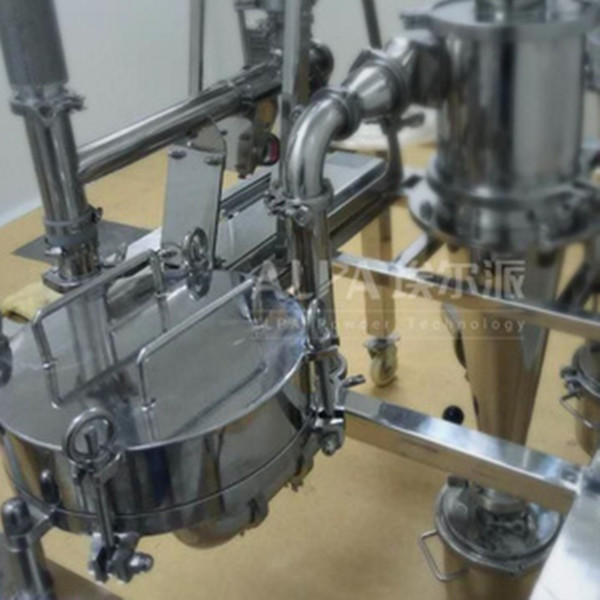 API ultrafine pulverization production line for a pharmaceutical company in Guangdong
API ultrafine pulverization production line for a pharmaceutical company in Guangdong
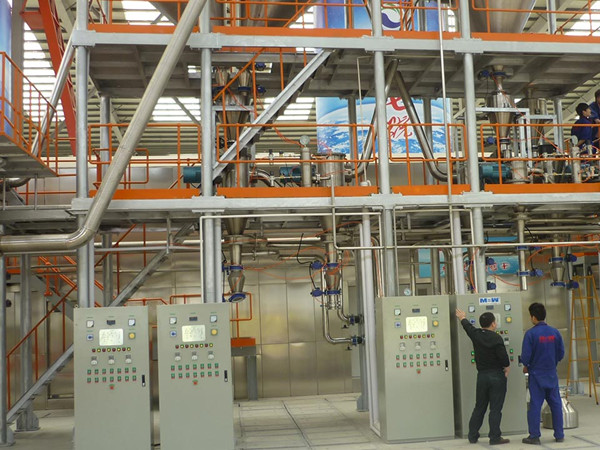 A Mining Group in Shandong Province: New Tin Powder Production Line
A Mining Group in Shandong Province: New Tin Powder Production Line
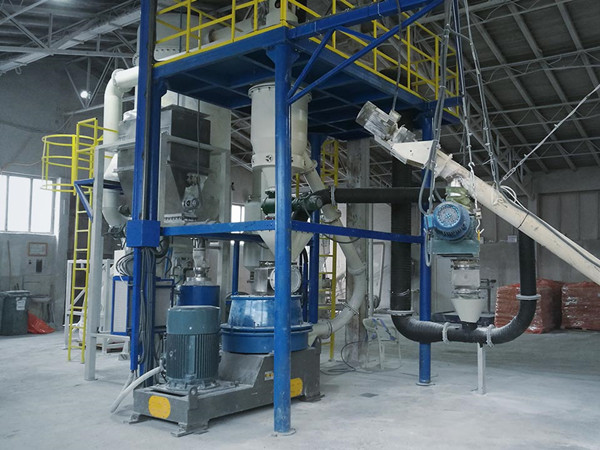 A heavy calcium carbonate ball milling and grading + modification production line in a mineral facto
A heavy calcium carbonate ball milling and grading + modification production line in a mineral facto
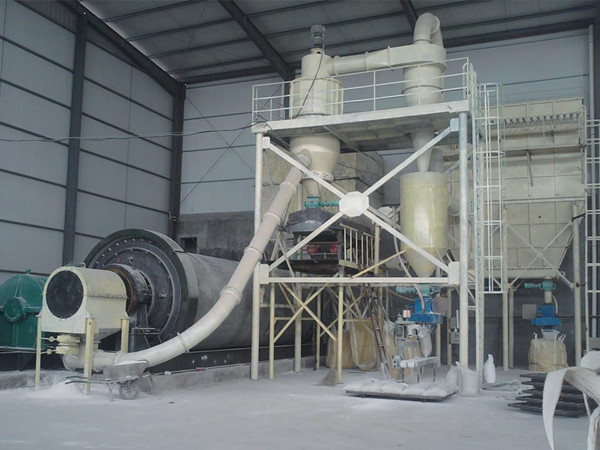 Quartz powder ball mill and air classifier production line in a mineral factory in Shandong
Quartz powder ball mill and air classifier production line in a mineral factory in Shandong
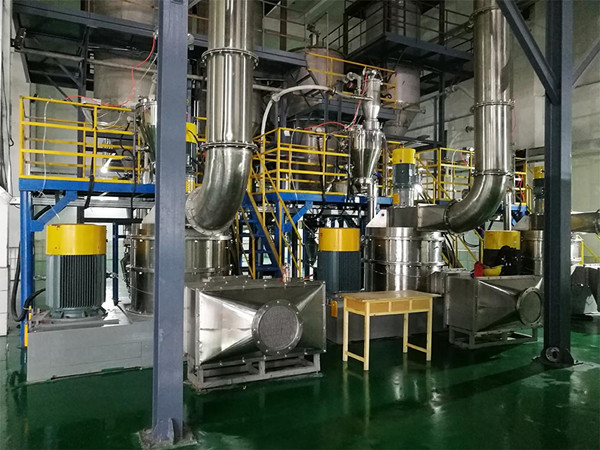 3M new material factory: Resin grinding mill production line
3M new material factory: Resin grinding mill production line